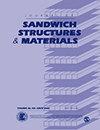蜂窝/碳-环氧夹层板II型断裂特征的不对称端缺口弯曲试验
IF 2.8
3区 材料科学
Q1 ENGINEERING, MECHANICAL
引用次数: 2
摘要
这项工作的目的是利用不对称端缺口弯曲(AENF)试验来确定蜂窝/碳环氧夹层板在II型载荷下的断裂能。实验测试和数值分析旨在验证所有程序。为了简化仅使用荷载-位移(P-δ)数据测定阻力曲线(r曲线)的实验,提出了等效裂纹长度数据约简方案。这种策略使得在裂纹扩展过程中不需要对裂纹长度进行监测,这在II型断裂试验中很难实现。采用混合模式I+II梯形内聚带模型验证了所提出的数据约简方法。结果表明,该方法适用于复合材料夹层板脱粘破坏的II型断裂表征。本文章由计算机程序翻译,如有差异,请以英文原文为准。
Mode II fracture characterisation of a honeycomb/carbon-epoxy sandwich panel using the asymmetric end-notched flexure test
The objective of this work is to determine the fracture energy of a honeycomb/carbon-epoxy sandwich panel under mode II loading using the Asymmetric End-Notched Flexure (AENF) test. Experimental tests and numerical analyses aiming to validate all the procedures were performed. An equivalent crack length data reduction scheme was developed in order to simplify the experimental determination of the Resistance-curves (R-curves) using exclusively the load-displacement (P-δ) data. This strategy makes unnecessary the crack length monitoring during its propagation, which is hard to perform in mode II fracture tests. A mixed-mode I+II trapezoidal cohesive zone model was used for validating the proposed data reduction method. It was concluded that this methodology constitutes a suitable procedure for mode II fracture characterisation of debonding failure in composite sandwich panels.
求助全文
通过发布文献求助,成功后即可免费获取论文全文。
去求助
来源期刊

Journal of Sandwich Structures & Materials
工程技术-材料科学:表征与测试
CiteScore
9.60
自引率
2.60%
发文量
49
审稿时长
7 months
期刊介绍:
The Journal of Sandwich Structures and Materials is an international peer reviewed journal that provides a means of communication to fellow engineers and scientists by providing an archival record of developments in the science, technology, and professional practices of sandwich construction throughout the world. This journal is a member of the Committee on Publication Ethics (COPE).
 求助内容:
求助内容: 应助结果提醒方式:
应助结果提醒方式:


